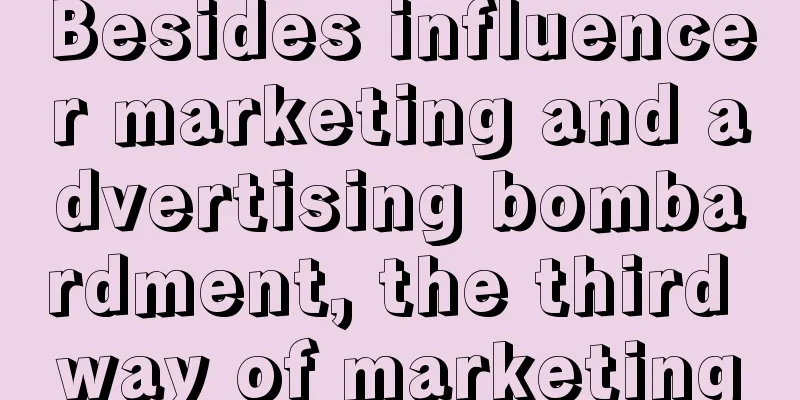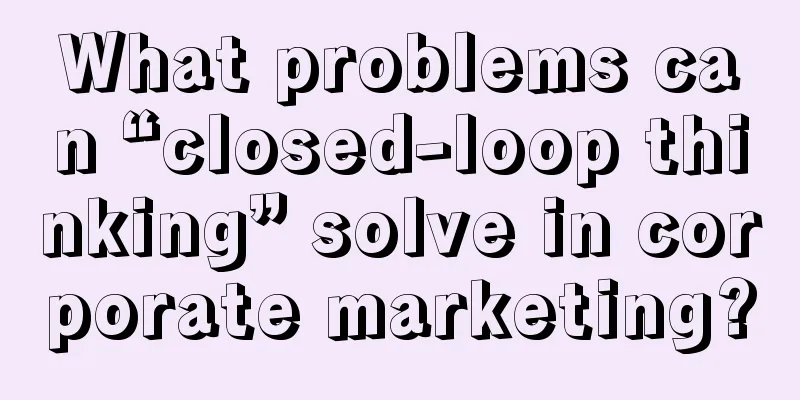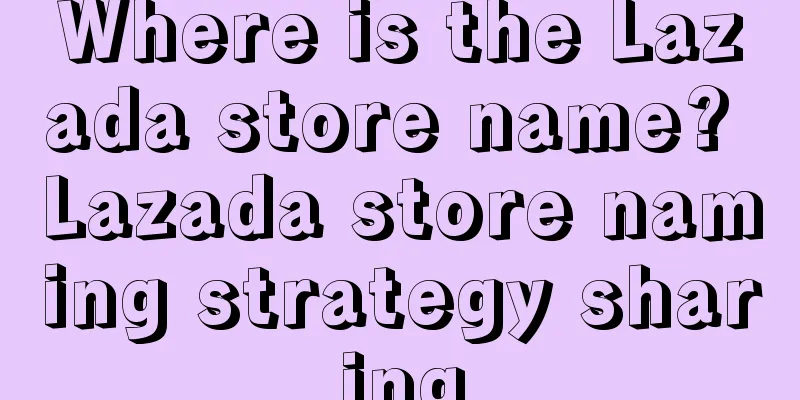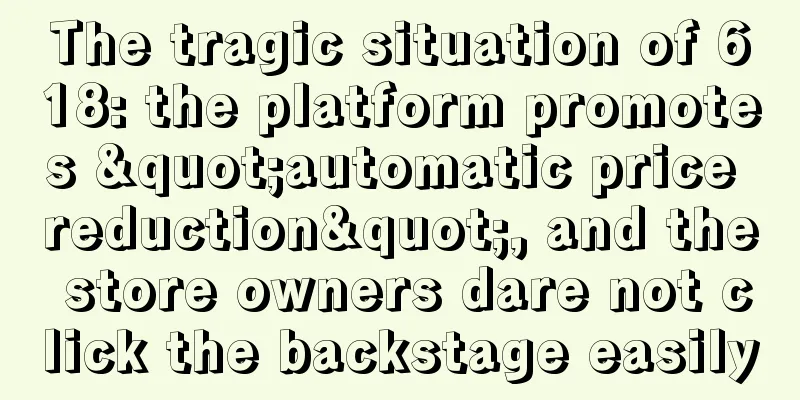Besides influencer marketing and advertising bombardment, the third way of marketing

In today's era of information explosion and media diversity, the marketing field seems to be dominated by two main paths. The first path is advertising bombardment, which originated from the golden age of television and is characterized by large-scale media placement, strengthening consumers' minds through repeated brand information. The familiar "Cheese, choose Mio Landou" or "David, the mop expert" are typical manifestations of this model. Although the number of such advertising models has decreased over time, there are still many brands doing this kind of marketing, firmly believing that it can gain popularity. The second path is influencer marketing. Similar statements about this marketing method were made a few years ago. A widely known formula is: new brand = 5,000 Xiaohongshu posts + 2,000 Zhihu Q&A posts + product promotion by Wei Ya and Li Jiaqi. Nowadays, there are not many people on Zhihu, and the two top anchors have also quit or are about to quit the live broadcast industry. But the concept of internet celebrity marketing has not disappeared. Generally speaking, today's internet celebrity marketing = endorsements by popular stars + recommendations by internet celebrities + live streaming by big anchors. Brands that have become popular in recent years, such as Yuanqi Forest and Huaxizi, are basically inseparable from these marketing methods. Both of these paths are currently encountering some problems. As for advertising bombardment, with the rise of the Internet and the fragmentation of the media landscape, the reach efficiency and conversion rate of traditional advertising are declining, and the difficulty in evaluating its effectiveness has made it face increasing challenges. As for influencer marketing, as the benefits gradually fade and top influencers frequently engage in chaotic sales, the ROI of this type of marketing is getting lower and lower, and it is no longer as successful as in previous years. In the early 20th century, some political scholars proposed the "third way", trying to find a new political route outside the two isms. I borrowed this concept and believed that marketing should not be limited to the above two models, but should have a third way. Compared with the above two paths that require large investments and focus on short-term results, the third path I define is brand building, which is a slow and meticulous, long-term approach. Brand building is more like a marathon, requiring endurance and perseverance. But in the end, a strong brand can bring lasting competitive advantages to companies, increase customer loyalty, reduce marketing costs, and enhance brand value. Since the first path - advertising bombardment is easier to understand, this article will not explain it too much. Therefore, it will mainly focus on the second path - Internet celebrity marketing and the third path - brand building. 1. Influencer Marketing VS Brand BuildingThe previous article described three paths of marketing: the first one is advertising bombardment, the second one is internet celebrity marketing, and the third one is brand building. Since they are different paths, there is no one higher or lower, it depends on which one you choose. Next, I will focus on the advantages and disadvantages of influencer marketing and brand building. Influencer marketing is a marketing method that most brands will adopt now. Its advantages are as follows: ● Rapid traffic: Internet celebrities and traffic stars have a huge fan base, and their recommendations can quickly bring a lot of exposure and traffic to the brand. ●High conversion rate: Compared with traditional advertising, influencer marketing generally comes with sales links, and the effect is measurable. In particular, live streaming has the characteristics of real-time interaction, which can quickly stimulate consumers' desire to buy and increase sales conversion rate. ●Precise positioning: The fan groups of internet celebrities and stars usually have clear attributes. Brands can achieve precise marketing by choosing suitable internet celebrities. ●Social proof: Internet celebrities themselves have great influence and credibility. Their recommendations and sharing of usage experiences can increase the credibility and reputation of brand products. But the disadvantages of influencer marketing are also quite obvious; ● High cost: The endorsement fees of popular stars and big anchors are usually very high, especially the fees of top internet celebrities are unaffordable for small and medium-sized brands. ● Unstable effects: Internet celebrities’ promotions are often unstable. They may sell well today but suddenly die out tomorrow. Their personal image is easily affected by various factors. If they have negative news, it will also have an adverse impact on the brand image. ●Consumer fatigue: With the popularity of influencer marketing, consumers have become aesthetically fatigued by the large amount of recommended content, resulting in a decline in marketing effectiveness. In the past year or so, the ROI of influencer marketing has actually been gradually declining. ● Over-reliance: Over-reliance on influencer marketing may lead to neglect of brand building and product quality improvement. Once influencer marketing stops, the effect will drop sharply. Brand building is a long-term marketing action. Compared with influencer marketing, it has its own disadvantages: ● Slow results: Brand building is a long process that requires continuous investment and patience, and it may be difficult to see significant results in the short term. ● Difficult to measure the effect: The effect of brand building is not as direct and quantifiable as influencer marketing, and it is difficult to quickly evaluate the specific benefits it brings. ●High resource consumption: A large amount of resources need to be invested in brand communication, customer experience optimization and product innovation, which may be particularly stressful for small and medium-sized enterprises. ● Complex management: It requires systematic brand management and operation strategies, involving brand positioning, image design, content marketing, customer service, etc. However, brand building also has significant advantages, which can play a longer-term role. ●Long-term stability: Brand building focuses on long-term value and can establish lasting brand loyalty and trust by continuously improving product quality and customer experience. ● Enhance brand identity: Enhance consumers’ sense of identity and belonging to the brand through consistent brand image and core value delivery. ● Strong ability to resist risks: The foundation of brand building is high-quality products and services, which are less affected by external factors and have strong ability to resist risks. ● Enhance brand value: Through continuous brand building, brand value and influence will gradually increase, which will help to form a competitive advantage in the market. The biggest feature of brand building compared to influencer marketing is that it has a brand effect. Once the initial brand building is completed, it can continue to create value, and even if the subsequent investment is reduced, it will not have much impact on sales. This is similar to the scale effect of an enterprise. As the user scale increases, the marginal cost becomes lower and lower, forming a cost advantage. The biggest feature of influencer marketing is that once it starts, it cannot be stopped. Once it stops, sales will be affected immediately. To put it in another way, it is like taking drugs. Brands quickly become addicted and cannot stop, and the dosage required will increase as time goes by. 2. The third path: how to build a brandBrand building is a long-term process. If you want to achieve this goal in the short term, don’t consider this process. Companies that insist on brand building, such as Apple, Tesla, lululemon, Yeti, Arc’teryx, and early Xiaomi, all have similarities in marketing. The following are the commonalities. ●Have a long-term perspective on brand assets. Brand represents popularity and trust. Building and maintaining a brand is a long-term project. Just like brands like Coca-Cola and Procter & Gamble, they have established stable brand recognition in the minds of consumers after decades or even hundreds of years of efforts. For example, Apple attached great importance to its brand when it was first founded. From designing the logo to establishing Apple's brand image, Jobs devoted a lot of effort. Just take a look at the early advertisement below, and Apple's fashionable and unconventional image is vividly reflected. It's this long-term perspective that has made Apple one of the most valuable brands in the world for decades. I talked about the relationship between brands and live streaming in "I heard that brand managers are about to exit the stage of history, and I'm so scared." Live streaming by internet celebrities to sell goods is a marketing tactic for a brand, but what kind of brand to build, how to build a brand, how to make the brand an asset, and how to make the brand play its value in the enterprise are strategies. This is why brand guru Kevin Keller emphasizes the word "strategy" in his book Strategic Brand Management. Strategic brand management includes brand positioning, executing brand activities, evaluating brand assets and enhancing brands. Live streaming by influencers is just a small tactic in executing brand activities. Brand is an asset. The value of brand assets cannot be solved by a single live broadcast. It must be accumulated over a long period of time. Brand is also a strategy. The tactics of live broadcasts by internet celebrities cannot solve strategic problems. ● Emphasis on vertical communities and community leaders I have observed many brands and found that those brands that attach importance to brand building, from small to large, all have one characteristic, that is, they attach importance to vertical communities. Their products and marketing are all launched from vertical communities from the beginning. For example, when Yeti, a cooler brand, started its business, it positioned itself as a high-end product in a niche vertical field, focusing on the fishing and hunting markets. After Yeti's first product was launched, it quickly became popular among fishing and hunting enthusiasts. These early users helped Yeti build a strong brand reputation among these core groups through word-of-mouth effects. Lululemon did not do paid marketing in the early days, but took community activities as an important part of its brand marketing strategy. The brand set up yoga experience halls in the community to provide potential consumers with an opportunity to experience it firsthand. In these experience halls, consumers can participate in free yoga classes and directly experience lululemon's products and brand culture. This interactive experience not only enhances consumers' awareness of the brand, but also promotes word-of-mouth communication. Xiaomi was also rooted in the community in its early days. In August 2010, one year before the release of Xiaomi mobile phone, Xiaomi's first version of mobile phone system MIUI was released and a community was established. At that time, Xiaomi had only 100 community users. By August 2011, when Xiaomi mobile phone was released, MIUI had 500,000 enthusiast users. These 500,000 users laid the foundation for the success of Xiaomi mobile phone. When Xiaomi 1 was released, these 500,000 enthusiastic users were the first to rush to buy the phone, and at the same time, more people became aware of the Xiaomi mobile phone brand. It can be said that Xiaomi’s success started with community marketing, and community marketing has been accompanying Xiaomi’s growth. For these brands, they did not look for influencer marketing in the early days, but instead worked with community leaders, whom they generally called "brand ambassadors." ● Word-of-mouth marketing is the main method To this day, I still believe that word-of-mouth marketing is the highest level of marketing. Word-of-mouth marketing first requires that the product and service must be the best in the market. To achieve this, as long as there is the first batch of media attention or consumer purchases, it will form a ripple effect, obtain more earned media, and drive consumers to line up to buy. Yeti's products initially spread from fishing and hunting enthusiasts to skiing, outdoor and other groups through word of mouth. When Yeti expanded into the thermos product line, it quickly gained wide recognition among college students and became one of the products that students aspire to own. In this group, various creative emoticons of Yeti products became popular on social networks. In its early expansion strategy, lululemon did almost no advertising and did not seek celebrity or star endorsements, but instead relied mainly on word-of-mouth marketing. Founder Chip believes that advertising and endorsements can only bring short-term attention, while word of mouth is the foundation for the long-term development of a brand. Lululemon's high-quality fabrics and unique flat seam design make yoga pants very comfortable to wear, so many people wear them not only when exercising, but also when going out. The popularity of this way of wearing has made lululemon yoga pants a beautiful sight on the streets. As more and more people choose to wear lululemon yoga pants in their daily lives, they gradually become highly visible mobile advertisements. When other people see these yoga pants and are attracted by their appearance and comfort, they will also try to understand and buy these products. In addition, some celebrities and stars have also begun to wear lululemon yoga pants in public. For example, Madonna, Jennifer Aniston, Gwyneth Paltrow and others are all loyal fans of lululemon. They often wear lululemon yoga pants on the streets, which has brought huge attention and influence to lululemon. Another manifestation of word-of-mouth marketing is that products always get earned media. Around 2012, when Apple was at its peak, marketing director Phil Schiller said in an interview that Apple no longer needed to do any advertising when launching new products. The company relied on only two strategies:
These two strategies are actually earned media. I wrote in "Why Can't Bad Guys in Movies Use iPhones?" that Apple's placement in movies and TV shows is free. The same is true for Tesla. It is no secret in the industry that Tesla does not do paid advertising, but it has never lacked news attention, and a large number of media and fans promote Tesla for free. ●Content strategy: Companies that focus on long-term and value-oriented brand building may not advertise, but they must create content, because this is one of the core elements of forming brand personality and accumulating brand assets. Tesla's official website has a separate module called Owner Stories, which records the stories of various car owners around the world and Tesla. These stories are not as circulated as viral videos, nor are they eye-catching, but they show the characteristics and image of Tesla. In the long run, they have a positive impact on both non-Tesla owners and existing Tesla owners. Yeti’s official website has a similar setup, and content is also updated on its YouTube channel. Its content marketing strategy is centered around real stories and high-quality visual content, focusing on building an emotional connection with users. Yeti’s content marketing is led by Arlo Rosner, executive producer and senior content manager. As an in-house agency and production company, Yeti’s content team consists of about 10 people, including a two-person camera team. They travel around the world, from the United States to Europe and New Zealand, to capture authentic and moving stories. For example, during its recent spring campaign, Yeti introduced two new colors. When promoting the color Granite Gray, they invited legendary rock climber Beth Rodden to shoot her climbing in Yosemite National Park, showcasing the toughness and strength of Granite Gray. When promoting the color King Crab Orange, they invited a Bering Sea crab fishing couple to shoot. The couple caught king crabs in the ice and snow, showing the vitality and enthusiasm of King Crab Orange. If you look closely at Yeti's videos, you will find that their content does not pursue the so-called "viral video" at all, but simply tells real stories, which is definitely a breath of fresh air in the marketing industry. 3. Conclusion:The third path, brand building, is a marathon full of endurance and perseverance. Compared with the short-term effects of advertising bombardment and influencer marketing, brand building emphasizes the accumulation and deep cultivation of long-term value. It requires companies to continuously invest in product quality, customer experience, brand image, etc., and ultimately form stable brand assets through the deep cultivation of vertical communities, the promotion of word-of-mouth marketing, and the careful creation of content strategies. Brand building can not only bring lasting market competitiveness, but also reduce long-term marketing costs. As well-known brands such as Apple and Tesla have shown, once a brand has established solid recognition and loyalty, even if advertising is reduced, the brand effect can continue to play a role, forming a snowball-like market advantage. As brand guru Kevin Keller said: "Brand is one of the most valuable assets of a company. Its true value lies in its ability to create and maintain long-term customer loyalty." |
<<: What do TikTok users like to watch? I flipped through the current comment section
>>: Xiaohongshu focuses on 7 common problems: how to solve the note life cycle and user inaccuracy?
Recommend
Is it easy to be an Amazon customer service representative? Is it hard to be an Amazon customer service representative?
As the global e-commerce giant Amazon grows strong...
Do Amazon sellers need to pay taxes in the country? What taxes do they need to pay?
Many merchants like to open stores on Amazon. Afte...
"Return rate" becomes a new challenge for Double 11
As the Double 11 Shopping Festival approaches, com...
What is the Shopee platform scam? Is the Shopee platform legal?
Before 2017, merchants could register as individua...
How to transfer an Amazon store? What information is required for transferring an Amazon store?
In some cases, sellers may need to transfer their ...
Is Amazon's Transparency Program good? What are the drawbacks?
As a cross-border e-commerce platform, Amazon has ...
Understanding Xiaohongshu's Commercial Traffic in One Article
90% of brands and merchants do not correctly under...
What does Amazon’s entry fee include? Introduction to Amazon’s entry fee
Amazon's cross-border e-commerce platform can ...
Wang Ma fell down, and Xing Ye stood up
There is a gap between "wild" and &quo...
Brand Upgrading? The Truth Planners Need to Understand
What does "brand starts high but product ends...
Is eBay the only payment method for PayPal? How do I connect eBay to PayPal?
eBay sells thousands or even millions of items eve...
College students are addicted to making money in their dorms: earning over 10,000 yuan a month, working all night to place orders
Before leaving school, some college students have ...
Oriental Selection “enters Taobao”, further loosening its ties with Douyin?
This article begins with a media report that Dongf...
How do new sellers on Amazon Europe choose products? Methods and techniques for selecting products
For new sellers, choosing the right products to se...
What are the consequences of Lazada’s incorrect pricing? What should I do if Lazada has incorrect pricing?
No matter what platform you open a store on, merch...









